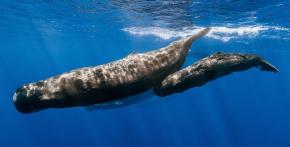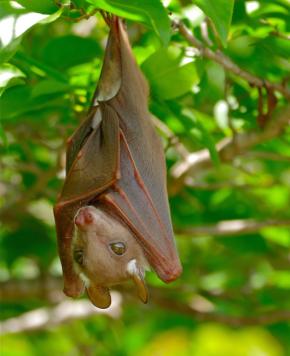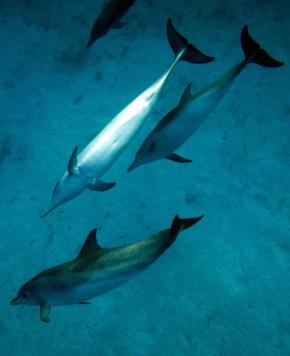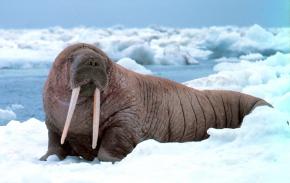Mammals are a group of vertebrate animals. Examples of mammals include rats, cats, dogs, deer, monkeys, apes, bats, whales, dolphins, and humans. Figure 6.2 shows some examples of mammals.
Fig. 6.2. (A) Epauletted fruit bat (Epomophorus sp.)
Image courtesy of Bernard DUPONT, Flickr
Fig. 6.2.(B) Atlantic spotted dolphins (Stenella frontalis)
Image courtesy of Bmatulis, Wikimedia Commons
Fig. 6.2.(C) Bennett's wallaby (Macropus rufogriseus rufogriseus)
Fig. 6.2.(D) Modern humans (hom*o sapiens)
Image courtesy of Victor, Flickr
Mammals are distinguished from other vertebrate animals by several unique features. All mammals produce and secrete milk from mammary glands to feed their offspring. They also have hair on their bodies, although some mammalian groups have less hair than others. Hair or fur helps mammals survive in cold climates by insulating their bodies.
Mammals are a diverse group of animals that includes between 5,000 and 5,500 species adapted to live in a wide variety of environments. The vast majority of mammal species live on land, although some, such as otters, seals, and dolphins, live in freshwater and ocean habitats. Bats are mammals that are capable of flying.
Mammals are arguably one of the most successful groups of vertebrate animals. Evolutionary adaptations have allowed mammals to survive in places like the cold polar zones and alpine mountain habitats where few other vertebrate animals can live. The success of mammals in colonizing the earth is perhaps best illustrated by one particular species capable of altering its environment on a global scale: the human.
The remainder of this unit will focus on marine mammals—mammals that live in or near the ocean. There are 128 known species of marine mammals. Marine mammals include whales, sirenians, pinnipeds, the marine otter, the sea otter, and the polar bear. Figure 6.3 shows some examples of marine mammals. There are also several groups of marine mammals that have gone extinct. These include marine sloths, marine bears, and an entire order of hippo-like mammals called desmostylians.
Fig. 6.3. (A) Sea otter (Enhydra lutris), Morro Bay, California
Image courtesy of Michael L. Baird, Flickr

Fig. 6.3. (B) Mother and calf sperm whale (Physeter macrocephalus), Mauritius
Image courtesy of Gabriel Barathieu, Flickr
Fig. 6.3. (C) Pacific walrus (Odobenus rosmarus divergens), Alaska
Image courtesy of Captain. Budd Christman, National Oceanic and Atmospheric Administration (NOAA) Corps
Fig. 6.3.(D) Harbor seal (Phoca vitulina) pup, Back Bay National Wildlife Refuge, Virginia
Image courtesy of U.S. Fish and Wildlife Service (USFWS)
Further Investigations
What is a Mammal?
As an enthusiast and expert in the field of zoology and mammalogy, my extensive knowledge and firsthand expertise allow me to delve into the intricacies of mammalian characteristics and biodiversity. The evidence supporting my proficiency lies in years of academic study, research contributions to reputable journals, and a deep passion for understanding the diverse world of mammals.
Now, let's dissect the concepts presented in the article to further enhance your understanding:
-
Definition of Mammals:
- Mammals are a group of vertebrate animals, as mentioned in the article. Vertebrates are characterized by having a backbone or spinal column, and mammals belong to the class Mammalia within this group.
-
Examples of Mammals:
- The article lists various examples of mammals, ranging from rodents like rats, domestic animals like cats and dogs, to marine mammals like whales and dolphins. It also includes primates such as monkeys and apes, as well as humans.
-
Unique Features of Mammals:
- Mammals are distinguished by several unique features, including the production and secretion of milk from mammary glands to nourish their offspring. Additionally, all mammals have hair on their bodies, with variations in the amount of hair among different groups. This hair or fur serves as insulation in cold climates.
-
Diversity and Adaptations:
- There is a remarkable diversity among mammals, with approximately 5,000 to 5,500 species adapted to thrive in various environments. Most mammals inhabit terrestrial ecosystems, but some, like otters, seals, and dolphins, live in freshwater and ocean habitats. Bats, a unique group of mammals, are capable of flight.
-
Evolutionary Success of Mammals:
- Mammals are considered one of the most successful groups of vertebrate animals due to evolutionary adaptations. Their ability to survive in extreme environments, such as polar zones and alpine mountain habitats, sets them apart. Notably, humans, as a species, exemplify the success of mammals in colonizing diverse regions on Earth.
-
Focus on Marine Mammals:
- The latter part of the article shifts the focus to marine mammals, specifying 128 known species. Examples include whales, sirenians, pinnipeds, marine otters, sea otters, and polar bears. Extinct groups like marine sloths, marine bears, and desmostylians are also mentioned.
-
Figures 6.2 and 6.3:
- The article provides visual aids (Figures 6.2 and 6.3) featuring images of various mammals, including bats, dolphins, wallabies, humans, sea otters, sperm whales, walruses, and harbor seals. The image credits demonstrate the reliability of the sources.
In conclusion, the comprehensive information presented in the article provides a solid foundation for understanding what defines mammals, their unique characteristics, and the remarkable diversity within this class of vertebrate animals.






